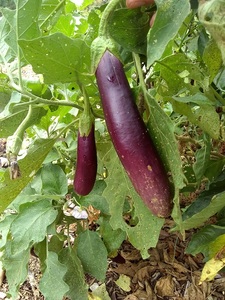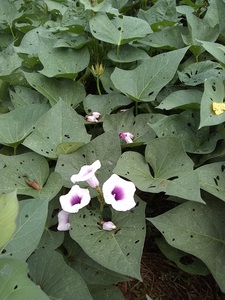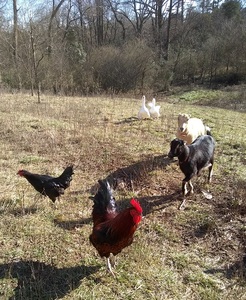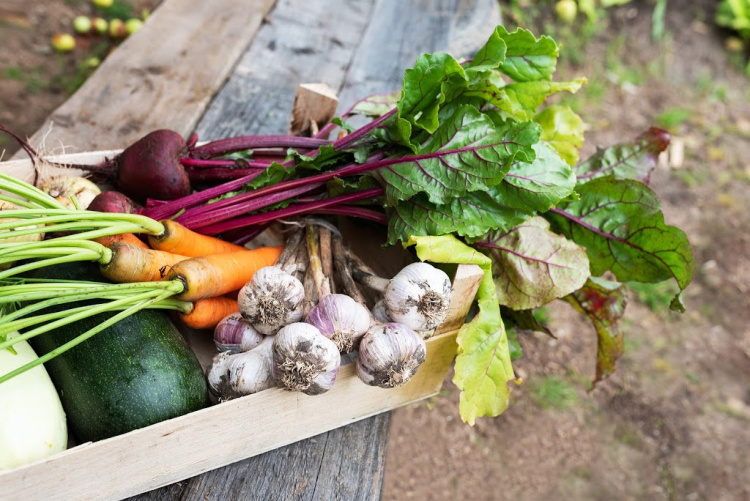If you're new here, you may want to subscribe to my RSS feed. Thanks for visiting!
by Kara Stiff
I grew up in Alaska. My family bought most of what we ate at the store, shipped in from the “Lower 48,” as the rest of the U.S. is known up north. The supply chains were long and fragile, and the produce was both expensive and terrible. Wilted lettuce, fuzzy strawberries, bruised apples. I couldn’t imagine why anyone would eat a peach or an ear of corn on the cob because after weeks in transit these delicacies taste like cardboard (or like rot). I ate ice cream, frozen hash browns and plenty of McDonald’s. Alaska is America, after all.
There was also another cuisine in my household, one born out of connection to the land. My family picked tart wild blueberries on the steep mountainside, with the tundra a spongy vermillion carpet around us and the first snows dusting the bare peaks above. We spent hours on icy glacial rivers or motoring past a pebbly shore, casting after salmon and halibut. We scoured the woods for wild mushrooms: nutty white King bolete (porcini), sweet-sour butter bolete, blue-bruising birch bolete, shaggy manes, and oyster mushrooms.
My eyes were opened when I was able to access other foods.
I got so sick of salmon that I refused to eat it, but the joke was on me because the salmon was already in my soul, residing there as a deep curiosity about unusual foods. As I attained adulthood and went traveling I sampled a long list of strange stuff: raw whitefish roe and muktuk (raw whale skin with the fat still on) in rural Alaska, alpaca and guinea pig in Peru, kangaroo and saltwater crocodile in Australia. I nibbled whatever was available: feijoa and loquat and dragon fruit, carpenter ant and raw jellyfish and bladderwrack seaweed, oysters smashed open on the beach.
This isn’t as strange as it sounds. Dr. Weston A. Price, the author of the classic book Nutrition and Physical Degeneration, was a dentist who traveled the world in the 1930s to document what people ate. His research includes 500 pages of pictures of people’s mouths and long lists of who did and who did not have cavities. At the edges of the Earth, Dr. Price found healthy people thriving on almost every imaginable diet: dried fish with a little oatmeal and cabbage in Scotland, cattle milk and blood plus wild vegetables in Africa, seal or caribou and berries in Alaska, cheese and rye bread with a little cabbage in alpine Scandinavia. Their teeth were flawless, their faces beautiful.
Not everyone was healthy, though. Some places Price visited, most people had had every tooth pulled from their heads by the age of 20. Some populations also had underdeveloped chests, high incidence of tuberculosis, crowded mouths and facial deformities, all from lack of nutrients. These folks were not eating a wide variety of different diets. They were all eating the same diet, which mostly consisted of white flour and jam.
There isn’t one perfect diet, because humans are omnivores that can thrive and be healthy on lots of different sets of foods. Just not on white flour and jam.
Now we’re eating wild and foraged things, plus what we grow.
These days, I live on a little homestead in rural North Carolina. My family has 17 acres of mixed woods and overgrown fields, with a pond and a stream. We have a little house we built with our hands, a garden, a young 
We still eat wild things, mostly violets and sheep sorrel, chickweed, wild spring onion, a few puffballs and blackberries, bass out of the pond. One year we found a bumper crop of shaggy-bark boletes that taste like the butter boletes I grew up with. One year I killed and cooked an egg-stealing rat snake (it made fine tacos).
But my county is farm country, a thoroughly humanized landscape since before Columbus when the natives burned the undergrowth to create a fantastically productive landscape that white settlers thought was a park. If we want to eat from the land rather than the Walmart (and we do), most of that food has to be encouraged to grow, not just hunted and gathered.
Growing food is a fascinating and complex endeavor fraught with failure and surprise. My favorite potatoes and English peas are tougher to produce here in the baking south than in the frozen north. Instead, I’m gradually learning to grow exotic things even the luckiest Alaskan gardener can only dream of, like eggplant, grinding corn, hot peppers, and sweet potatoes.
Some growing seasons are successes and others are lessons.
This year was an education in drought. In June we had a 100-year flood that took out the bridges on two of the four roads into our property. Nine months later, those bridges still aren’t fixed. After that deluge, it hardly rained for three
Corn, actual corn growing in the field rather than moldering on the produce shelf, is a revelation! I have a hand-crank grinder that makes dried corn into something that is 50% coarser version grit and 50% a flour almost as fine as masa. This year we planted a variety called Blue Clarage, which grows to 11 feet and cooks up purple! It looks like a dessert rather than dinner, and it tastes like popcorn. I cook it in milk or bone broth and put some sautéed eggplant or tomatoes and cheese over it.
We’re still buying that cheese at the store because goats have proven challenging. Dump a few goats on a deserted island and in a decade they’ll have overrun it, but around here our soils are too low in selenium for them to thrive. If I don’t supplement my little herd carefully, does are too weak to expel a placenta after birthing. Kids are born dead or weak. They also need copper supplements, tetanus vaccinations, and disturbingly frequent antibiotic rescues. I’m sticking with them, though. I can’t learn anything if I give up.
I haven’t given up on four-season gardening, and this year I had much better success than in the past. By choosing frost-tolerant varieties and deploying some very low-tech season extension tools like cold frames and row cover, I can harvest fresh food year-round. The trouble is, fall crops need to be sown in August and September in my area. You know, the hottest, busiest, most exhausting peak of the summer, when all I want to do is go lay in the lake. This year I nursed some beets, mustard spinach, chard, carrots, radishes, cilantro and arugula through the heat. I’m still cutting arugula under the row cover at the end of February.
One recent pleasant surprise involves cowpeas. I have not succeeded in growing dry beans, which is a shame 
Of course, some experiments just don’t work out. Every year there is too much okra, and every year I am compelled to do something just atrocious with it, at least once. Okra lasagna comes to mind. We still haven’t found enough favorite sweet potato or pumpkin recipes. I plan to work harder on swapping out store-bought rice and flour for these more nutritious carbohydrates we can easily grow, but sometimes a kid just wants a pizza.
Chickens have been a successful addition to our food production system, both for the protein and vitamins they add to our diet and for the services they provide. We appreciate the pest and weed control, the high-quality manure and the entertaining antics. Spare roosters are culled at six months for stir-fries and sautés, while older hens go into the crockpot as chicken gumbo or arroz con pollo. All bones are simmered low and slow for broth, which replaces meat in many of our favorite dishes. Then the stripped bones are burned in the woodstove and added with the ash to the garden.
Our relationship with food is emotional, not just digestive.
Learning to cook and enjoy what thrives on our little homestead is a constant challenge. Our relationship with food is an emotional one, not just a digestive one, and sometimes I long for the cheek-cramping wild blueberry preserves or grilled salmon hearts of my youth.
I wonder if my children will grow up, leave home and crave nutty, home-ground corn or fried okra. I hope they take their gardening skills with them, wherever they go.
About Kara
Kara Stiff grew up in Anchorage, Alaska and got her BS in Sustainable Agriculture from the University of Maine. Now she lives with her husband, two small children and some number of goats on 17 acres in rural North Carolina. She documents her family’s journey toward resilience, community engagement and a lower environmental impact at low-carbonlife.org.


















I enjoyed this article. This is a great reprieve from the news.
Don’t let the msm fool you. What is going on in the stores right now is not prepping. What it is,is hoarding and panic driven buying of storage food and other essentials. Prepping is done with thought and planning. I’ve been prepping since the mid nineties, gradually building my pantry up. This is the beginning of a smear campaign of people who act responsibly. Be safe out there.
Good stuff. Growing food is important on many fronts and has benefits in many other ways than just a full belly.
Yep.
It is that time of year.
While there still is snow on the ground, we have seen formations of Canadian geese heading north.
Time to start the seedlings indoors.
I suggest:
Growing sprouts and growing micro greens.
They are grown indoors, and you need very minimal equipment.
Both are easy to do, and produce a crop quickly.
Wonderful post. You have a lovely writing voice, Kara. This could easily have been written by Barbara Kingsolver or Gary Paul Nabhan. Keep ’em coming, please. A wonderful reprieve from the negativity all around. Your food culture descriptions gave me a smile.
Good luck with the goats!
I think that’s by far the nicest thing I’ve ever heard about myself in the internet. I do love Barbara Kingsolver 🙂 Thank you for reading.
Your writing is wonderful. Very poetic. I’m currently having the same problem with goats. Very discouraging. Not sure what I would do in a SHTF situation or what a long term solution is – possibly dousing the soil in a selenium supplement ?
Thank you for the lovely compliment! Sorry about your goats 🙁 goat problems are so frustrating. I looked at soil supplementation, and it seems that azomite may be a possible solution for very small scales. But selenium is rare enough on the earth that I’m not sure we would want to try to supplement large areas of soil with it. I’m hoping to address it partly by allowing more browsing and less grazing. But while goats are a great way to get high quality food right now, I have to conclude they aren’t any kind of resilience plan, not in my area. Not least because they are LOUD, and all my neighbors know I have them for about a mile around. Not a stealth animal at all.
For goat issue get selenium salt blocks they are cheap and last forever.
Second goat issue make kambucha and feed both the scoby and the kambucha to chickens and the goats as prebiotics stops scours (diarrhea and bloody stools.in chickens from bacterial Infection)
Enjoyed the article. Thank you.
I live in the hot south too…purple hull peas, okra, eggplant, tomatoes & peppers. We get almost NO winter here and only a few days of spring and fall.